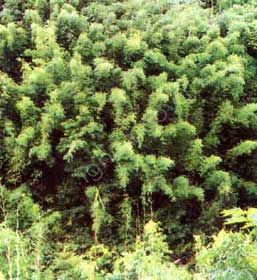Janapada Sampada
Bamboo, The Giant Grass

Bamboos are tall perennial grasses found in the tropical and sub-tropical regions of the world. It has been able to fulfill an astonishing variety of human needs from time immemorial, which includes dwellings complete with walls, flooring, ridge poles, doors and windows and even sleeping bunks and a number of functional articles in everyday use throughout the countryside. Bamboo’s utility is not confined to human needs alone but his environment too. It enriches the soil, binds the earth against raging floods and the tremors of earthquakes. It gives man tools to work with, instruments to make music, toys to play, and weapons to fight and provides paper to write.
The grass grows naturally in every continent except Europe and Antarctica, but is most abundant in Southern Asia. There are about 255 varieties of bamboos all over the world. Out of these 57 varieties are found in India alone. The North-Eastern States account for 44 out of these 57 varieties. They range from plants, the size of field grass to giants of 120 feet in height and a foot of thickness.
No other living thing grows so tall and so fast. Like many grasses, the bamboo has its mainstream (rhizome) underground and the tall, woody, stately culms with their feathered plumes of foliage are only the serial shoots, renewed annually. Bamboo thrives best in monsoon forests where they can attain their maximum development. Hot and humid climate with an even distribution of rainfall (200-300 mms) of rainfall per annum throughout the year are ideal for bamboo growth. Bamboo has a peculiarity. Most of its flowers bloom only at long intervals of 30, 60 or even 120 years apart as compared to all plants of the same species, at about the same time wherever they are in the world will bloom into flowers and burst into seeds gregariously.
A bamboo seedling to reach full growth and maturity in planned vegetation takes about 5-10 years. The bamboo has a prolonged and seasonally replenished vegetative life, with its culms renewed every year. Bamboos fall into two main categories- Sympodial or clump type bamboo and Monopodial or runner type bamboo. All bamboos come up from rhizomes, underground stems that sends up shoots, clump type multiply symmetrically outward in a circle, whereas the runner type sends its rhizomes in all directions, throwing up new culms here and there. Clump types are usually tropical and the runners are temperate zone plants. Bamboo is composed of Laginin (the main woody substance), fat and wax which constitutes the main body. Pectose is the colouring material. Bamboo is porous and its pores run vertically in close straight and regular series along the length. Its grains are straight; only the nodes have grains. The pores form capillary tubes throughout the length; in the green state, these tubes are filled with sap, and in the dry state with air. A fully matured bamboo therefore does not shrink in size when dried up. Whereas, a green bamboo shrinks by 10% in circumference. The inside of the bamboo is hollow and filled with air. The length of the internodes and the hollow spaces vary in different species. Due to hollow space in the internodes and the air in the pores of the skin, bamboo floats in water in both the green and the dry states. Bamboos are conspicuously absent on acidic, saline and alkaline soils. Bamboos avoid heavy clays in mixture with lime and water logging. Bamboos can be made to grow into square, rectangular and triangular shapes for low cost housing, handicraft and decorative items.




